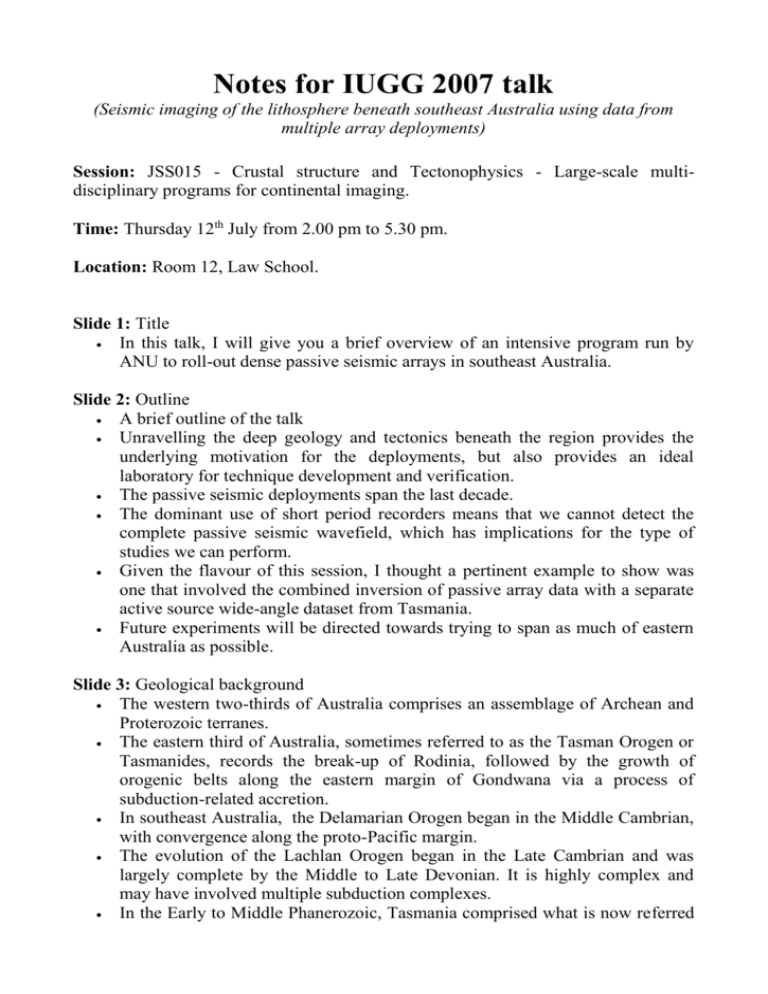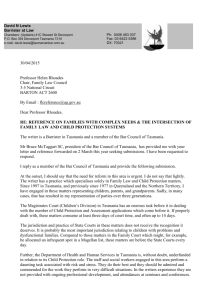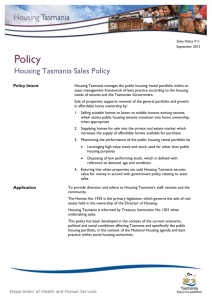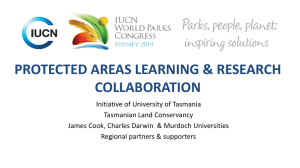Notes for IUGG 2007 talk (Seismic imaging of the lithosphere
advertisement

Notes for IUGG 2007 talk (Seismic imaging of the lithosphere beneath southeast Australia using data from multiple array deployments) Session: JSS015 - Crustal structure and Tectonophysics - Large-scale multidisciplinary programs for continental imaging. Time: Thursday 12th July from 2.00 pm to 5.30 pm. Location: Room 12, Law School. Slide 1: Title In this talk, I will give you a brief overview of an intensive program run by ANU to roll-out dense passive seismic arrays in southeast Australia. Slide 2: Outline A brief outline of the talk Unravelling the deep geology and tectonics beneath the region provides the underlying motivation for the deployments, but also provides an ideal laboratory for technique development and verification. The passive seismic deployments span the last decade. The dominant use of short period recorders means that we cannot detect the complete passive seismic wavefield, which has implications for the type of studies we can perform. Given the flavour of this session, I thought a pertinent example to show was one that involved the combined inversion of passive array data with a separate active source wide-angle dataset from Tasmania. Future experiments will be directed towards trying to span as much of eastern Australia as possible. Slide 3: Geological background The western two-thirds of Australia comprises an assemblage of Archean and Proterozoic terranes. The eastern third of Australia, sometimes referred to as the Tasman Orogen or Tasmanides, records the break-up of Rodinia, followed by the growth of orogenic belts along the eastern margin of Gondwana via a process of subduction-related accretion. In southeast Australia, the Delamarian Orogen began in the Middle Cambrian, with convergence along the proto-Pacific margin. The evolution of the Lachlan Orogen began in the Late Cambrian and was largely complete by the Middle to Late Devonian. It is highly complex and may have involved multiple subduction complexes. In the Early to Middle Phanerozoic, Tasmania comprised what is now referred to as the West Tasmania Terrane. The major event which shaped western Tasmania was the Middle to Late Cambrian Tyennan Orogeny. The East Tasmania Terrane contains no evidence of the Tyennan Orogen or Proterozoic outcrop, and it is widely thought that the two terranes were juxtaposed during th Middle Devonian Tabberabberan Orogeny. The presence of exposed Precambrian blocks in western Tasmania appears to exclude a tectonic affinity with the Lachlan Orogen; however, the similarity of Devonian granites in southern Victoria and northern Tasmania suggests that Tasmania was in its current position by the Middle Paleozoic. Recent work, including tomography results from our passive array experiments, suggests that the Tyennan Orogeny in Tasmania represents the southern extension of the mainland Delamarian Orogeny. Slides 4-12: Deployment history Over the last decade, nearly ten passive seismic arrays have been deployed throughout southeast Australia. Originally, these arrays used vertical component short period seismometers (L4Cs with a natural frequency of 1 Hz), but recently, they have been upgraded to 3-component short period seismometers (LE-3Dlites with a natural frequency of 1 Hz). The main objective of these array deployments has been 3-D P-wave teleseismic tomography. However, other types of analyses are also possible. LF98, MB99 and AF00 are subsets of the MALT experiment, undertaken by Monash and Adelaide Universities between 1998-2000. Each of these arrays were deployed for a period of approximately 4 months. The TIGGER and SETA arrays in Tasmania have a station spacing of 15-20 km, compared to 40-60 km for the mainland stations. The SETA and SEAL2 arrays use 3-component short period seismometers. Slide 13: Data return – MB99 The use of short period recorders and a lack of local earthquakes means that body wave teleseisms are the dominant class of data that is recorded. Thus, much of the global body wavefield is represented to some extent – P, PcP, ScP, PP, PKiKP etc. Slide 14: Data return – SEAL Core phases are particularly evident on the mainland arrays, some distance from the coast. Slide 15: Data return - SETA S-waves can be observed (mostly by the 3-component stations), although they are generally less evident than P. Slide 16: Data return – SETA Surface waves from large earthquakes are also evident, although the shape of the amplitude transfer function (exponential drop-off below 1 Hz) for the short period sensors means that waves with periods above about 10s are hard to detect. In this example, we can clearly observe the arrival of a Love wave. Slide 17: Data return – SEAL – ambient noise cross-correlation Long term cross-correlations of the ambient noise field between station pairs reveals the high frequency Rayleigh wave empirical Green's function. These waveforms can be exploited using seismic tomography to map shallow to mid-crustal structure. The example shown is not very symmetrical due to the one-sidedness of the oceanic disturbances that provide the ambient noise source. Slide 18: Research Potential Data recorded by the short period passive arrays provide a variety of research opportunities. This flow diagram summarizes some of the possibilities. Slide 19: Lithospheric structure of Tasmania – Active and passive source datasets This example shows how we can combine data from one of the passive arrays (TIGGER) with data from an active source experiment which was carried out independently. This is an example of value-adding. The 3-D wide-angle experiment (TASGO) was carried out in 1995, and involved the deployment of 44 analogue and digital seismometers throughout Tasmania to record approximately 36,000 airgun shots fired off-shore in a complete circumnavigation. A total of 3,172 Pg, PmP and Pn traveltimes are extracted from this dataset for stations in northern Tasmania. The teleseismic dataset comprises 6,520 arrival time residuals from 101 teleseismic events. The total number of traveltimes used to constrain structure is therefore 9,692. Note that the azimuthal distribution of teleseismic sources is not even, with much fewer events from the south and west that the north an east. Slide 20: Lithospheric structure of Tasmania – Tomographic method An iterative non-linear inversion scheme designed to integrate multiple classes of body wave traveltime data is used to constrain structure. Structure is parameterised in 3-D spherical coordinates, and can include both continuous velocity variation and undulating interfaces, both of which are represented by cubic B-spine meshes. The central innovation of the scheme is its use of a grid based eikonal solver, known as the Fast Marching Method, to solve the forward problem of traveltime prediction. Sources may be teleseismic, local earthquake, and active (e.g. for wide-angle and reflection experiments). A subspace inversion scheme is applied to solve the inverse problem of adjusting model parameters to better satisfy data observations subject to damping and smoothing regularization. The iterative process of traveltime prediction and inversion ensures that the non-linearity of the problem is accounted for. Slide 21: Lithospheric structure of Tasmania – Imaging results Comparison of slides at 15 and 52 km depth shows that the velocity structure of the crust and upper mantle is not very similar. The elevated crustal velocity region in the east, which is underlain by a shallower mantle, is quite well resolved. This feature helps to confirm the hypothesis that eastern Tasmania is underlain by rocks with an oceanic crustal affinity, which contrasts with the continentally derived siliciclastic core of western Tasmania. It is likely that this region of Tasmania began as a passive margin in the Ordovician, with subsequent episodes of orogenisis and sedimentation compressing and thickening the oceanic crust. Notably, the Tamar Fracture System, which has traditionally been used to mark what was thought to be the juxtaposition of two crustal elements, does not overlie the transition in crustal character. The thicker crust beneath the central northern part of Tasmania may well be a consequence of crustal shortening associated with the mid-Devonian Tabberabberan Orogeny. The easterly dipping zone of higher velocity material is well constrained, and is unlikely to be an artifact related to smearing. This feature may represent remnants of a Mid Cambrian easterly dipping subduction zone, associated with the mainland Delamerian Orogeny. Recently, boninites (relatively siliceous group of basaltic or andesitic rocks normally found in island-arc settings, and may be a product of the early stages of subduction) of a similar age and composition have been found in both locations. The thinner, higher velocity crust in northwest Tasmania is bounded to the southeast by exposed Cambrian ophiolites (mafic to ultramafic igneous rocks associated with pelagic sediments, which represent segments of oceanic crust emplaced in the continent by plate collision) at the surface, which suggests that this change in crustal character may be related to a prior collision zone in the region (also supported by the dipping higher velocity structures). The shallow high velocity anomaly beneath central northern Tasmania correlates quite well with the surface exposure of the Cambrian Mt. Read Volcanics, a highly mineralized metal province. Slide 22: Future experiments In the short term, one of the aims is to try and combine all the teleseismic data in a single inversion for upper mantle structure. One could also combine the ambient noise data to image the shallow to mid-crustal structure beneath the entire region. Contingent on future funding, we will attempt to propagate the array northwards as far as possible, where there is no shortage of juicy geological targets.







